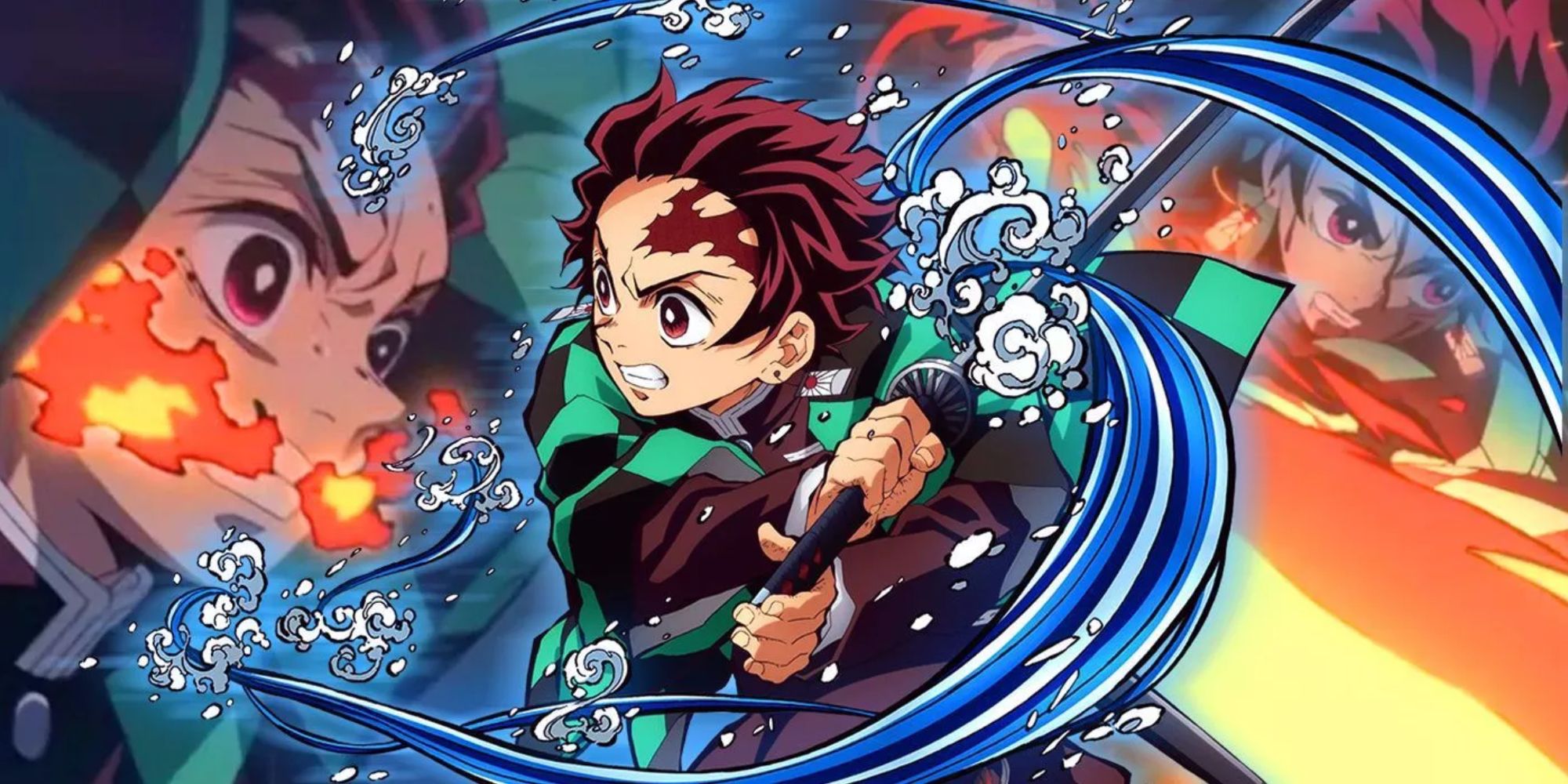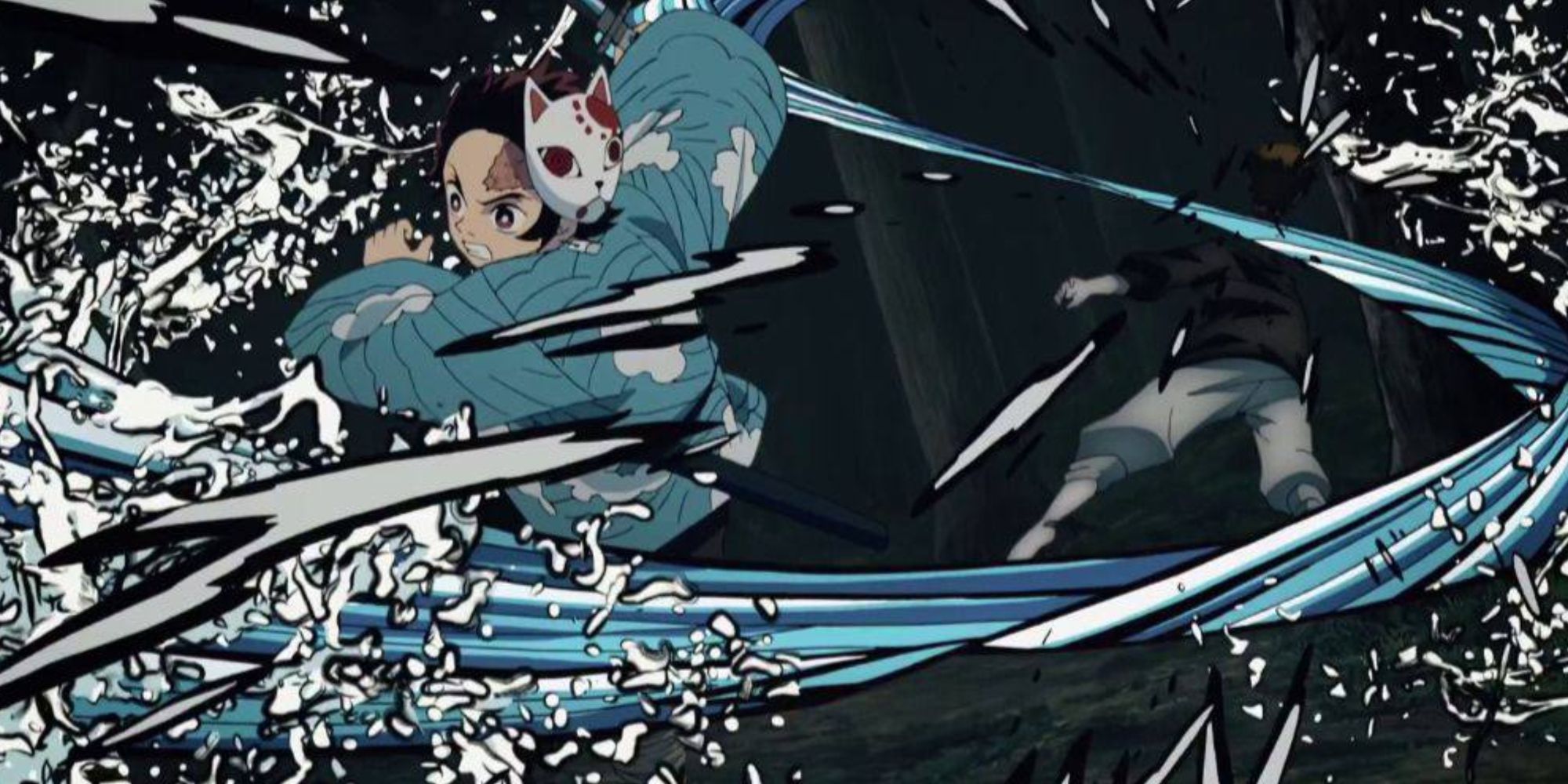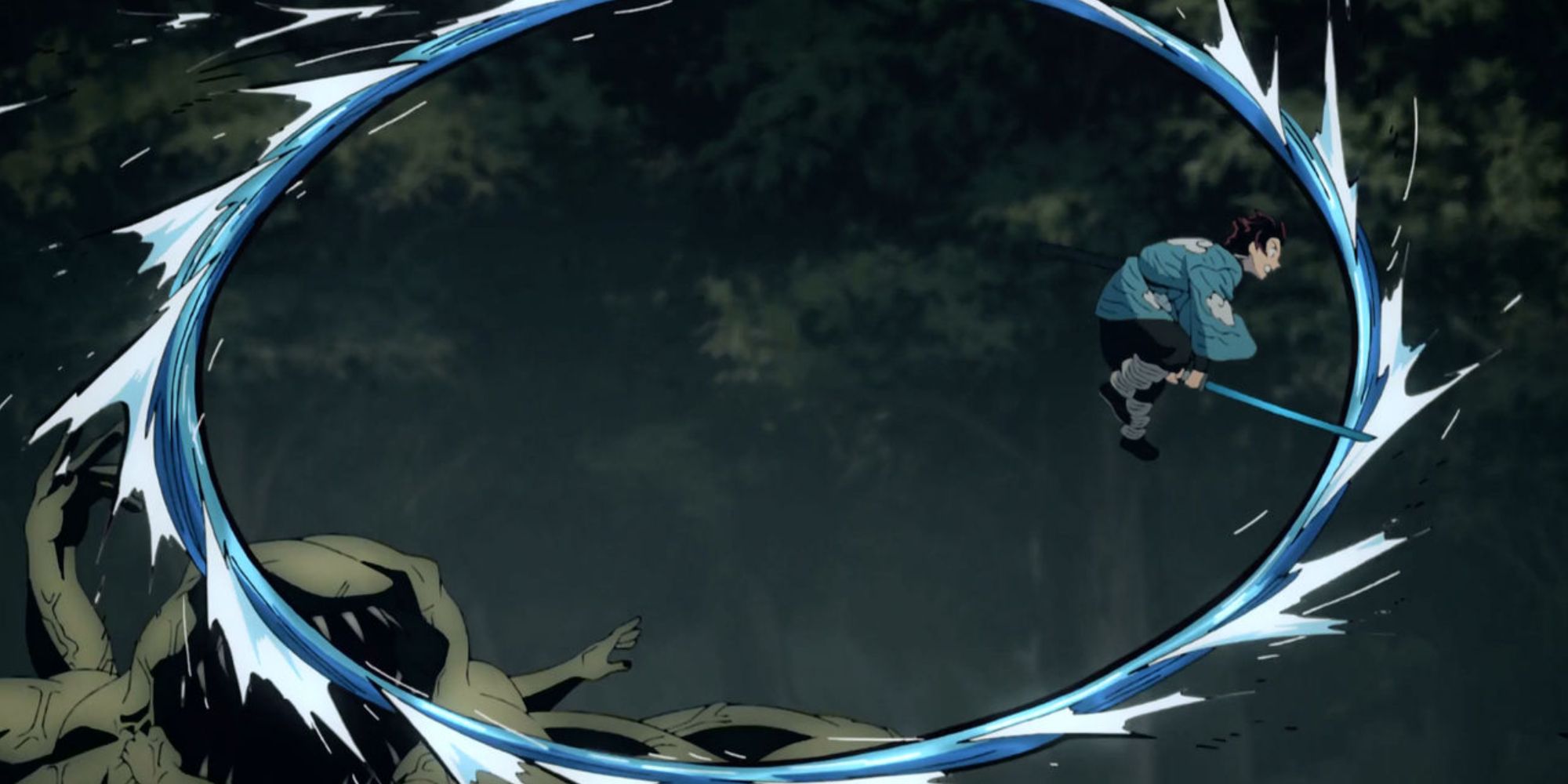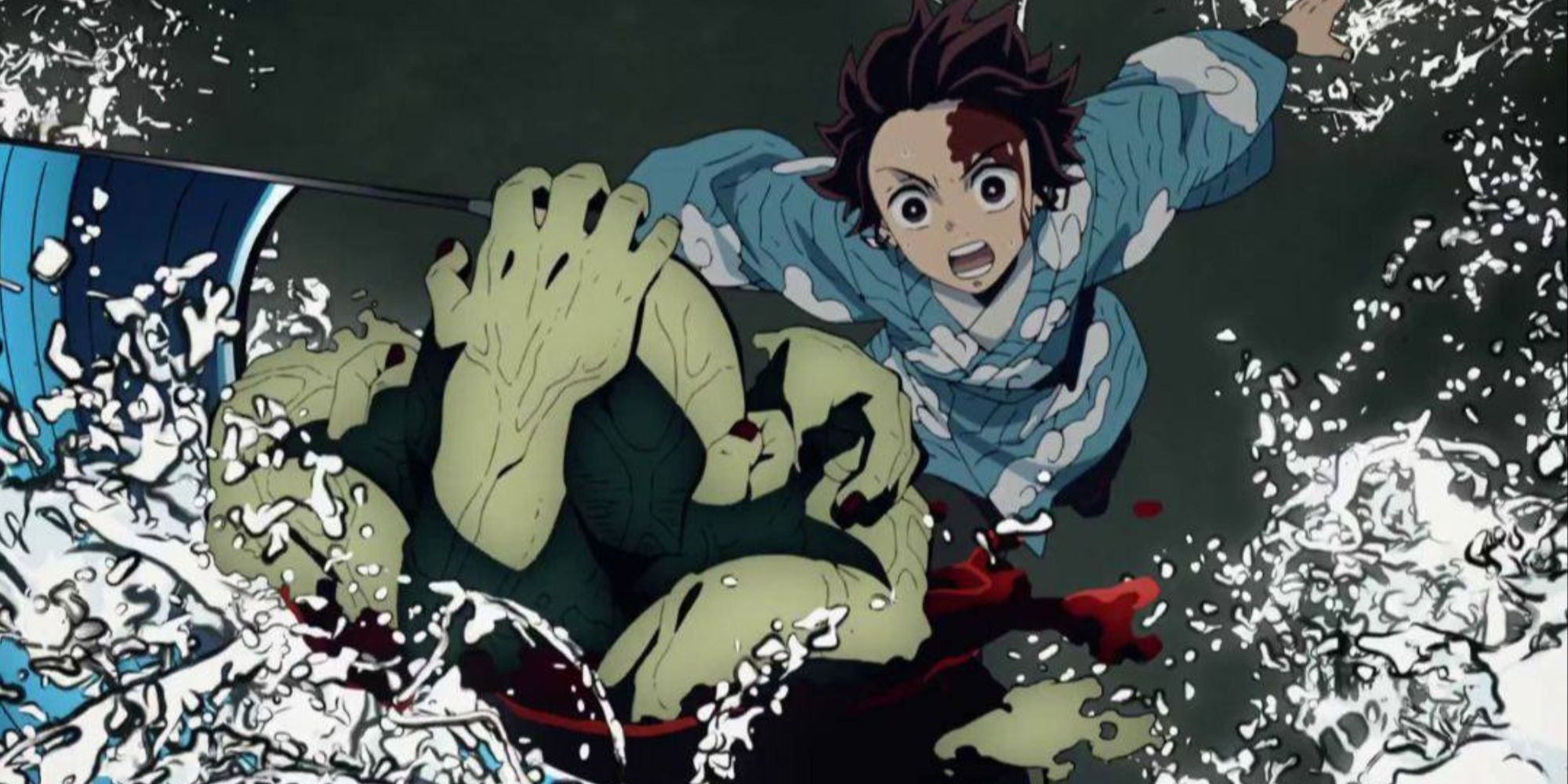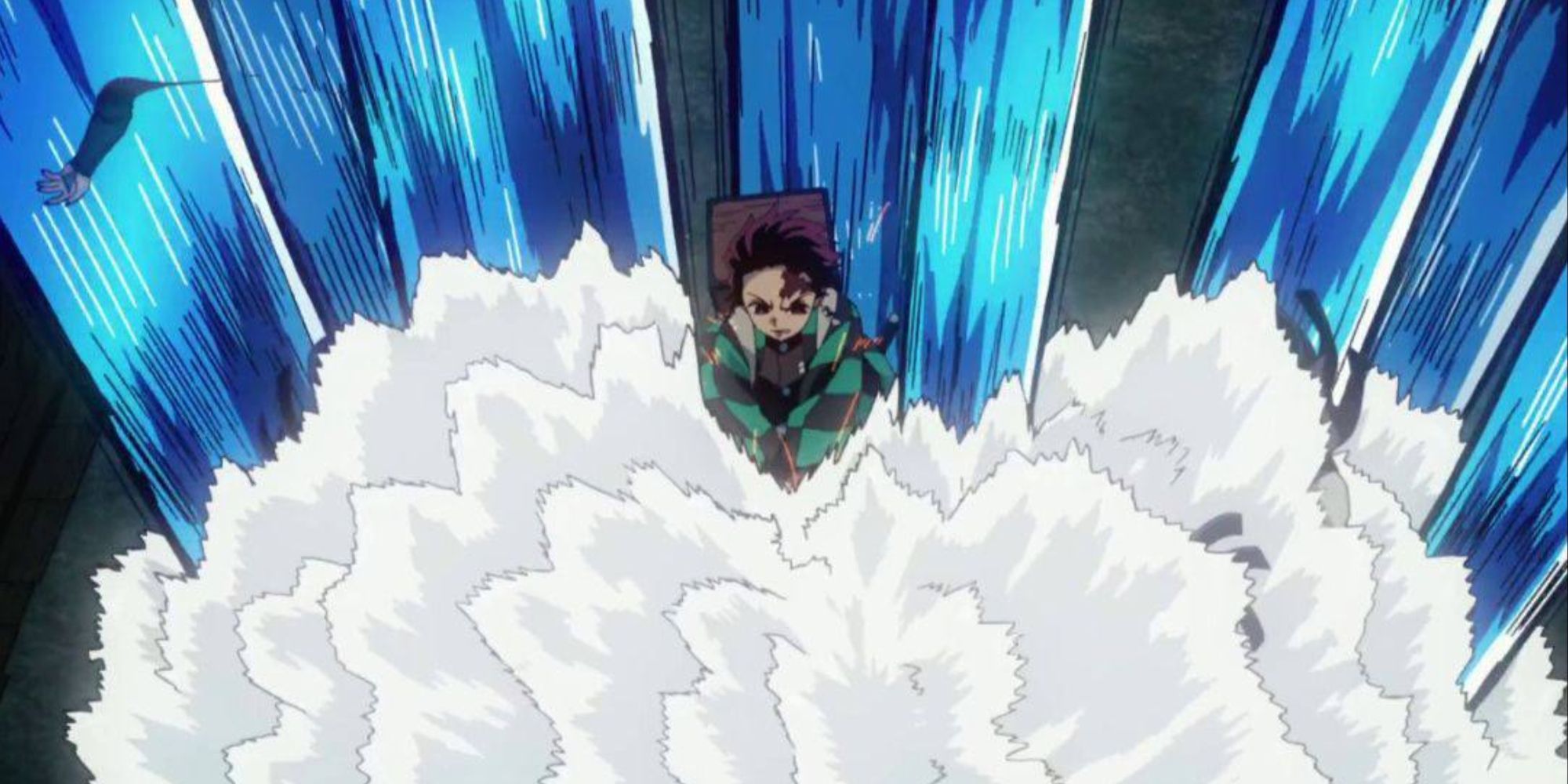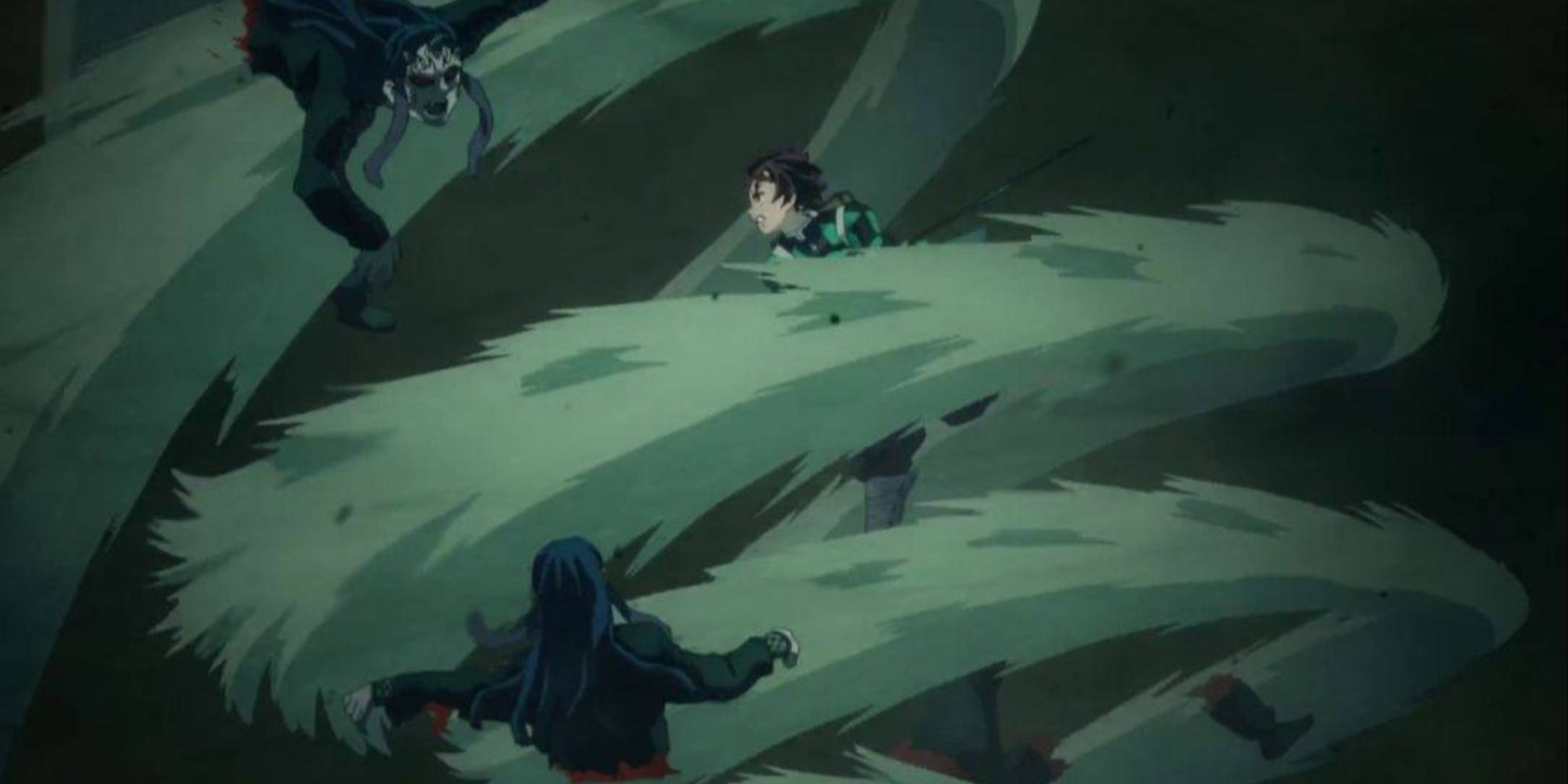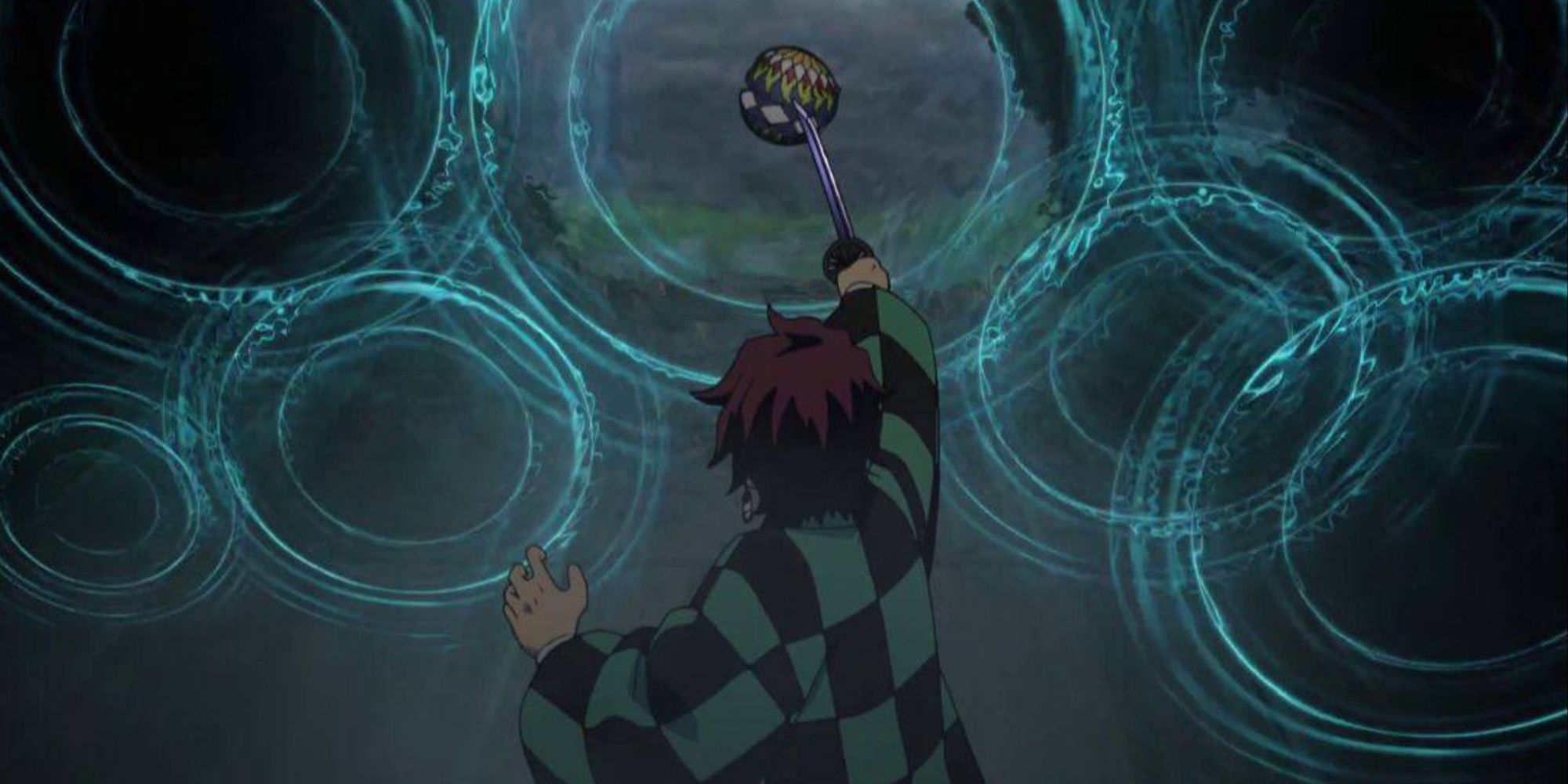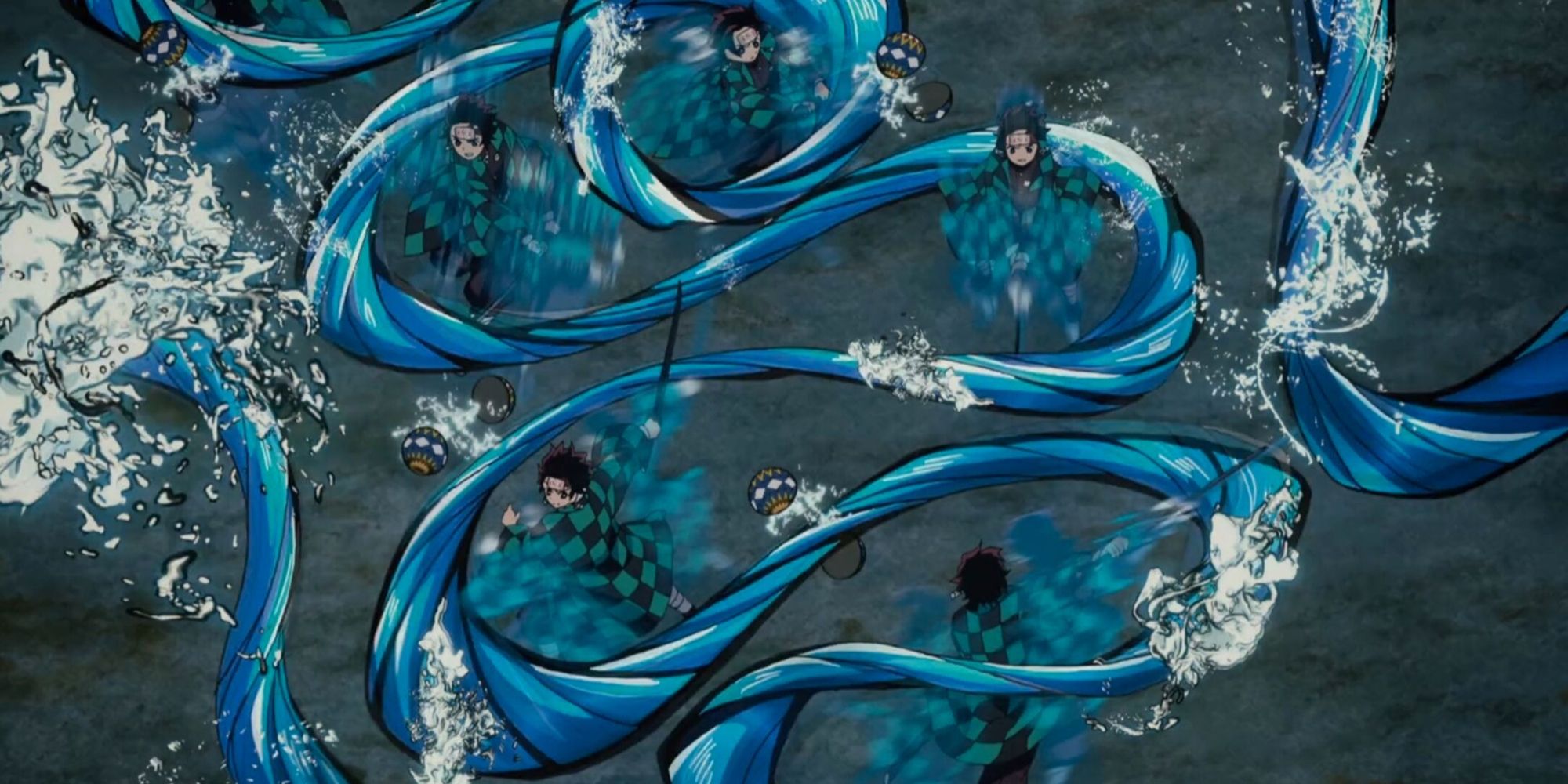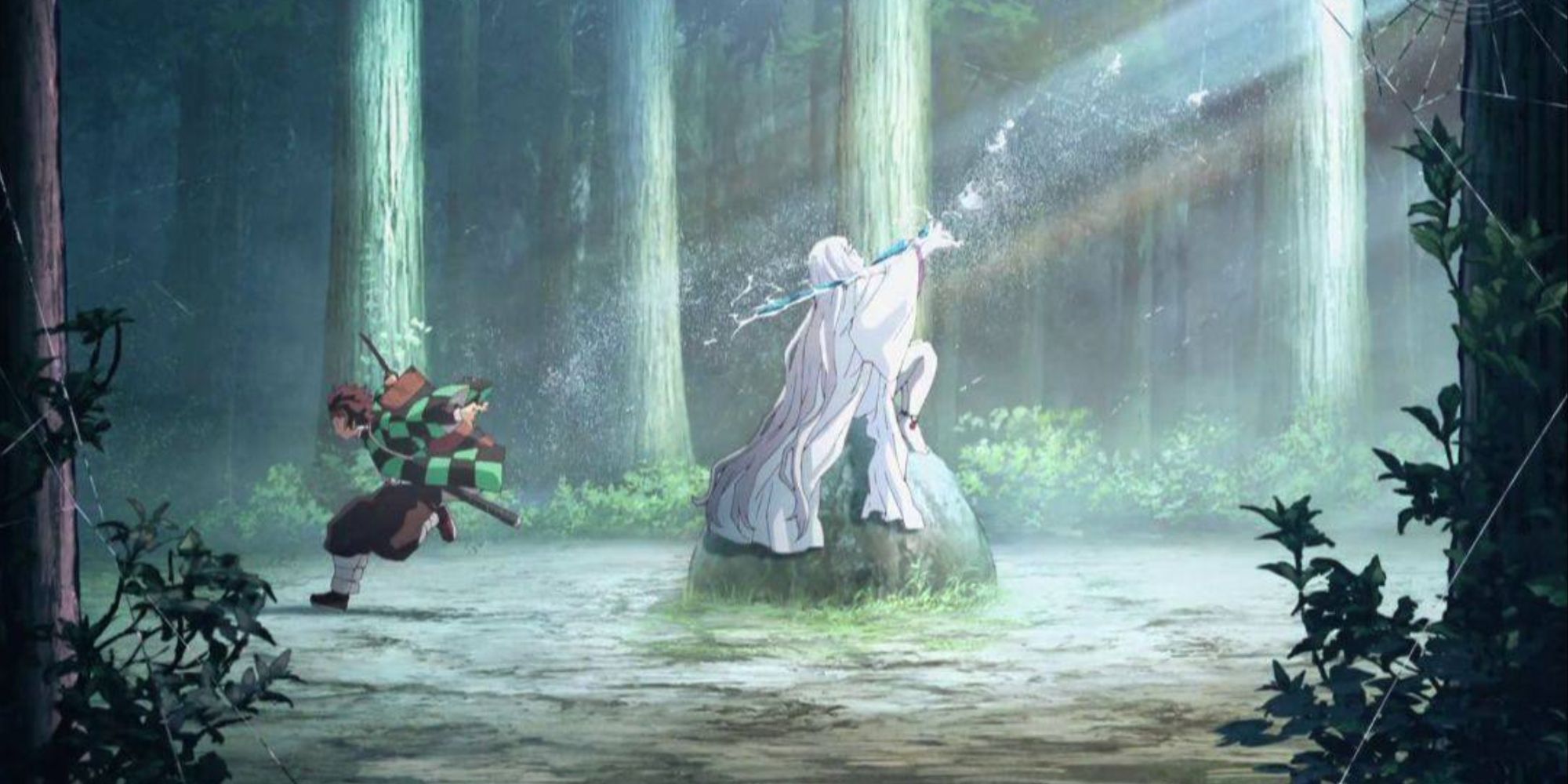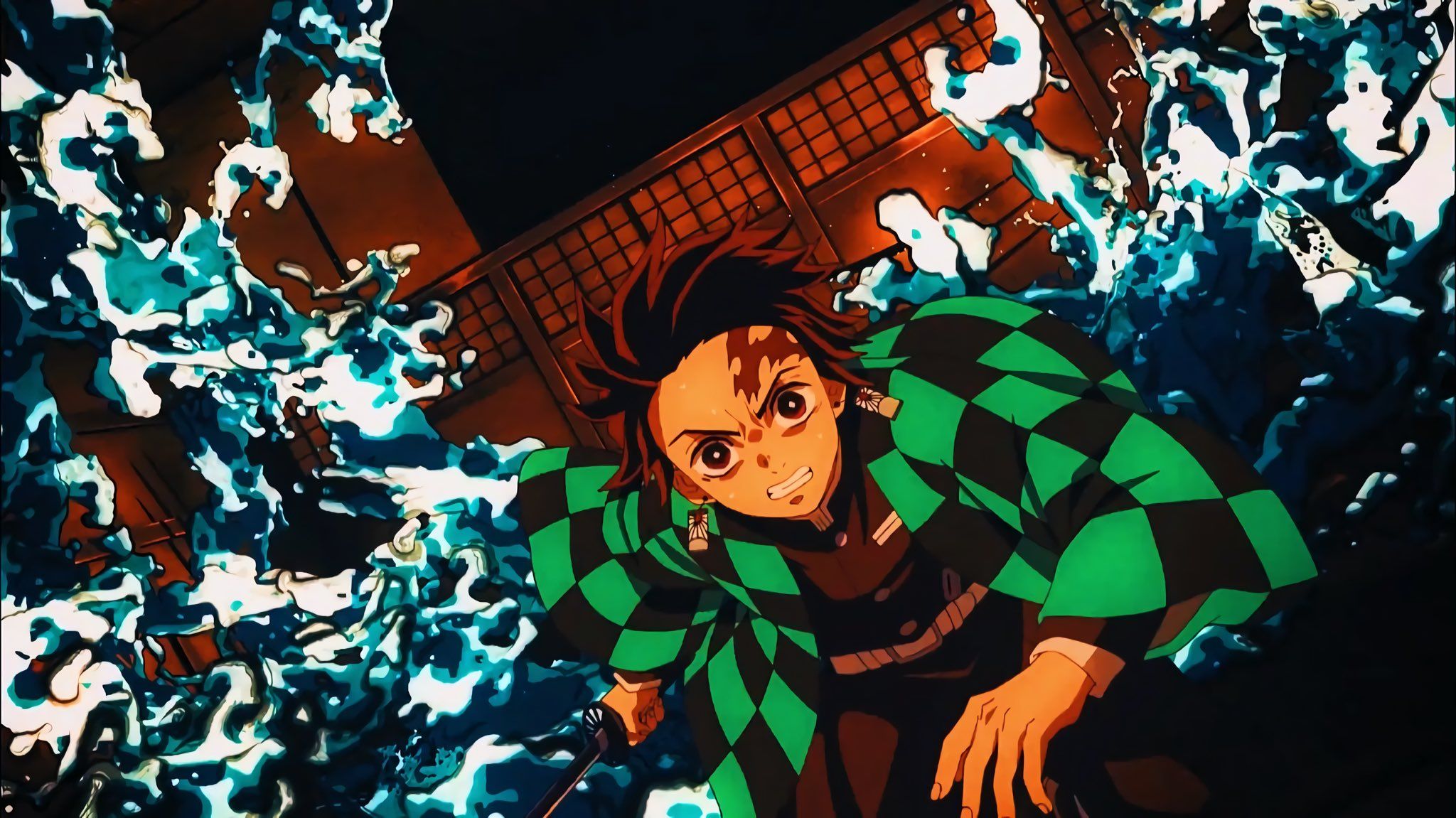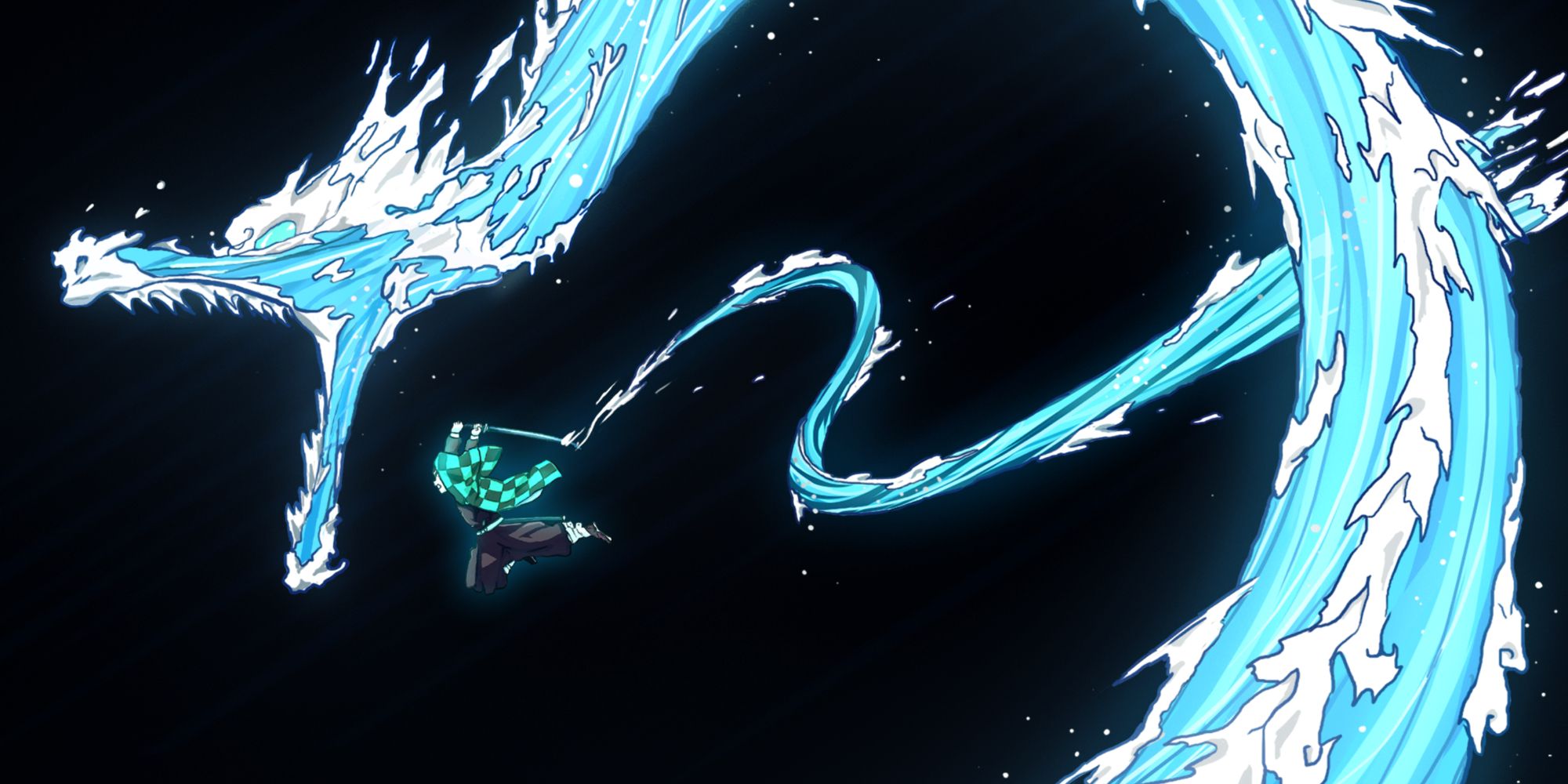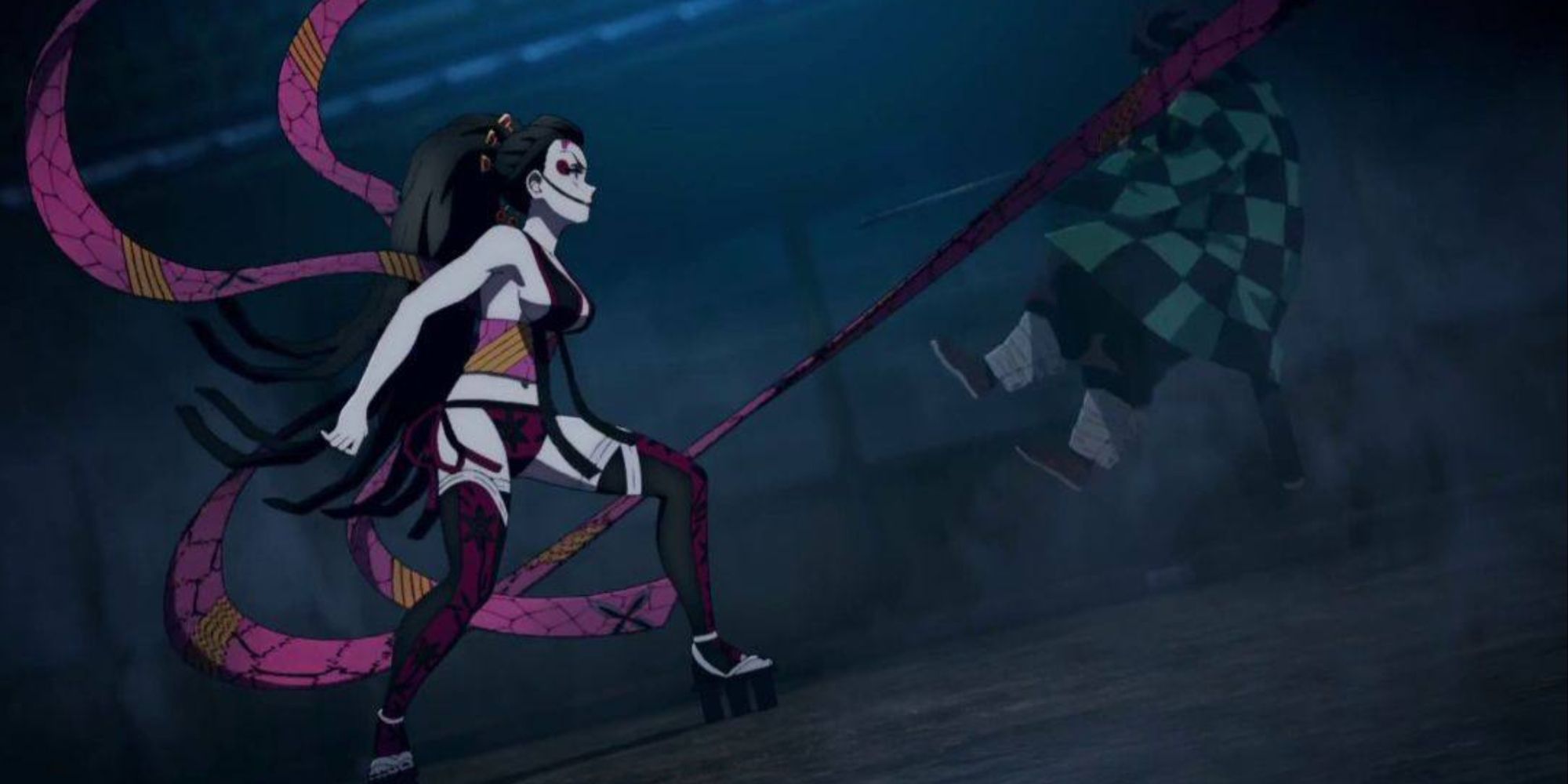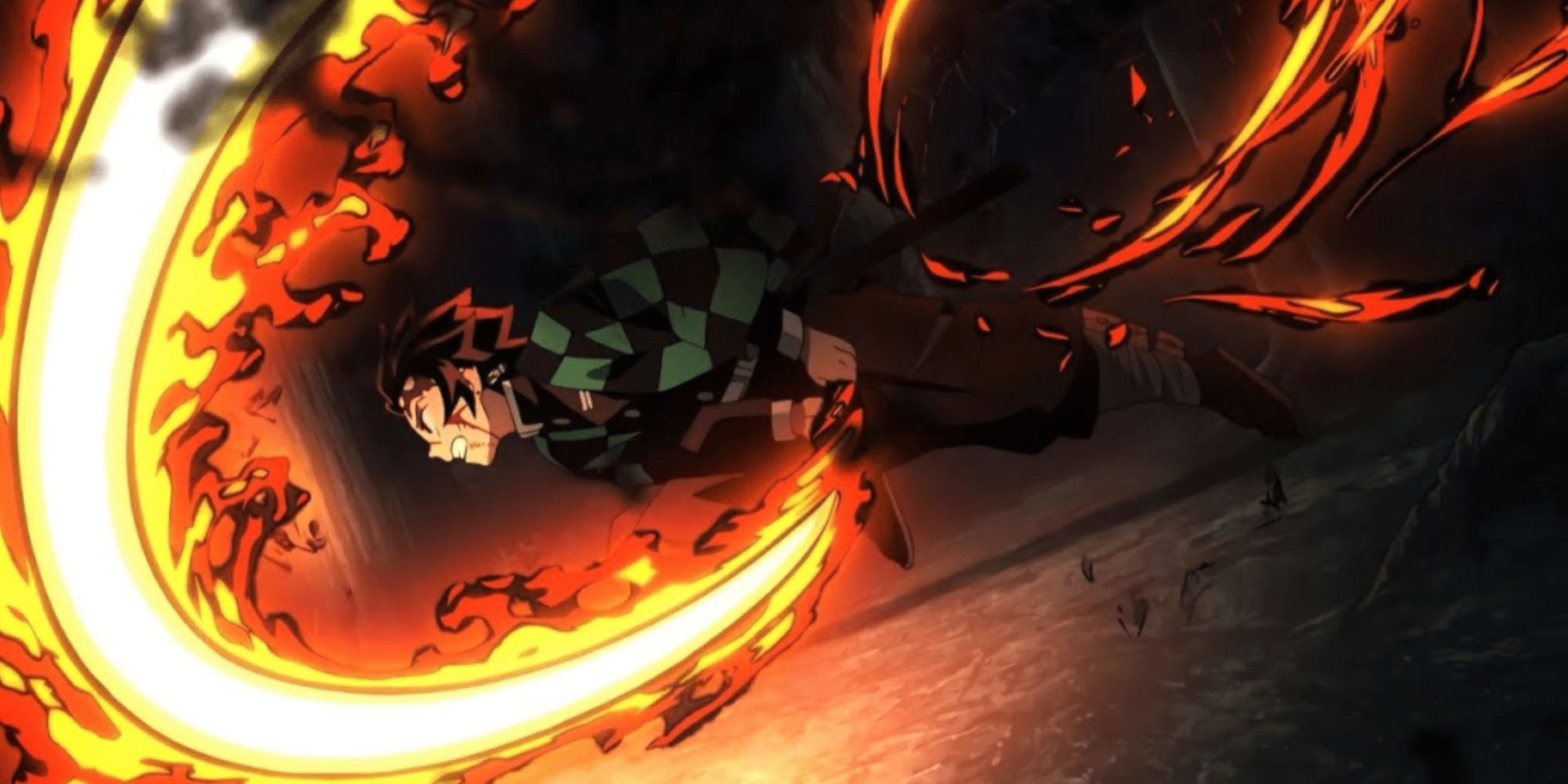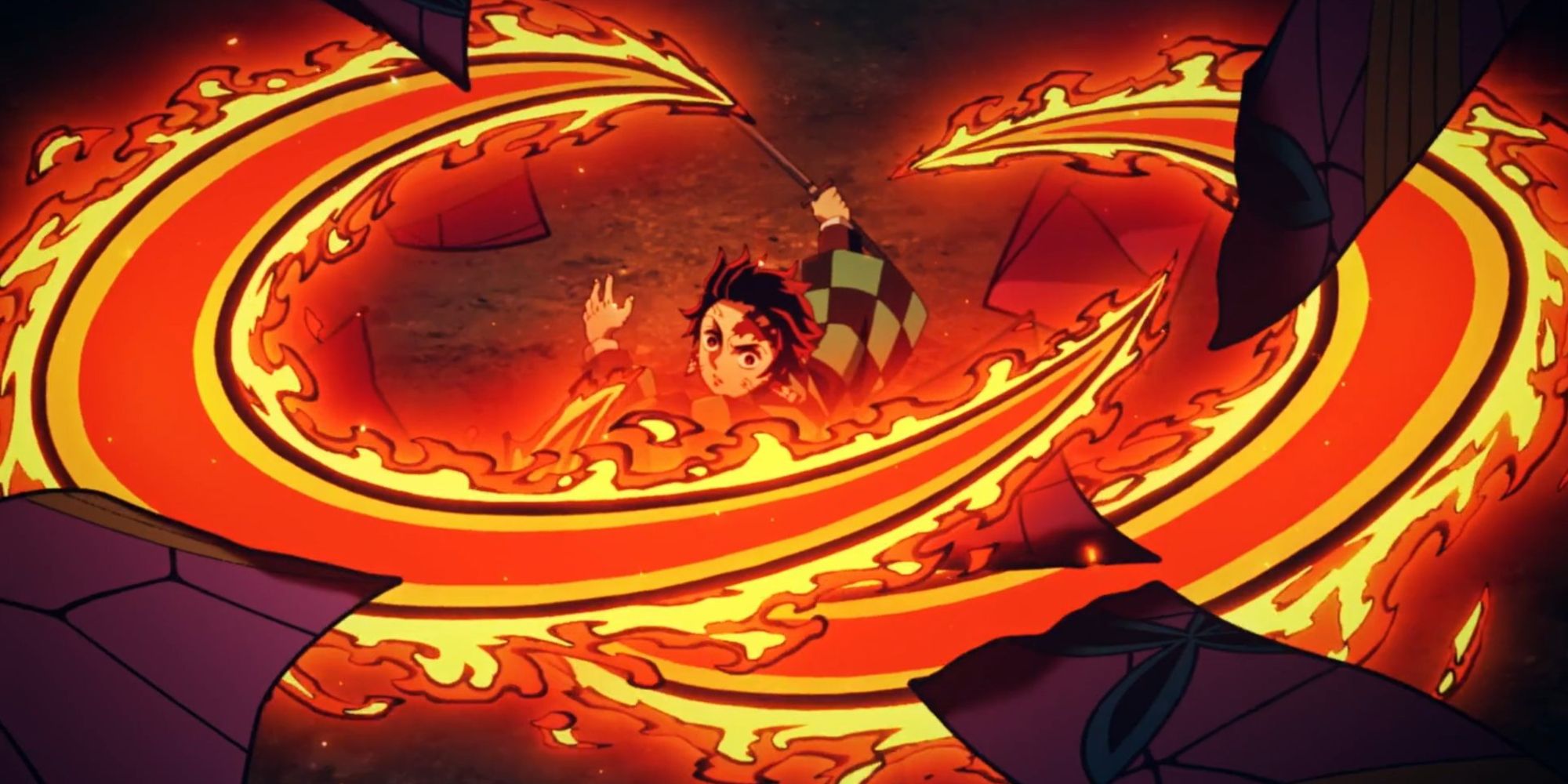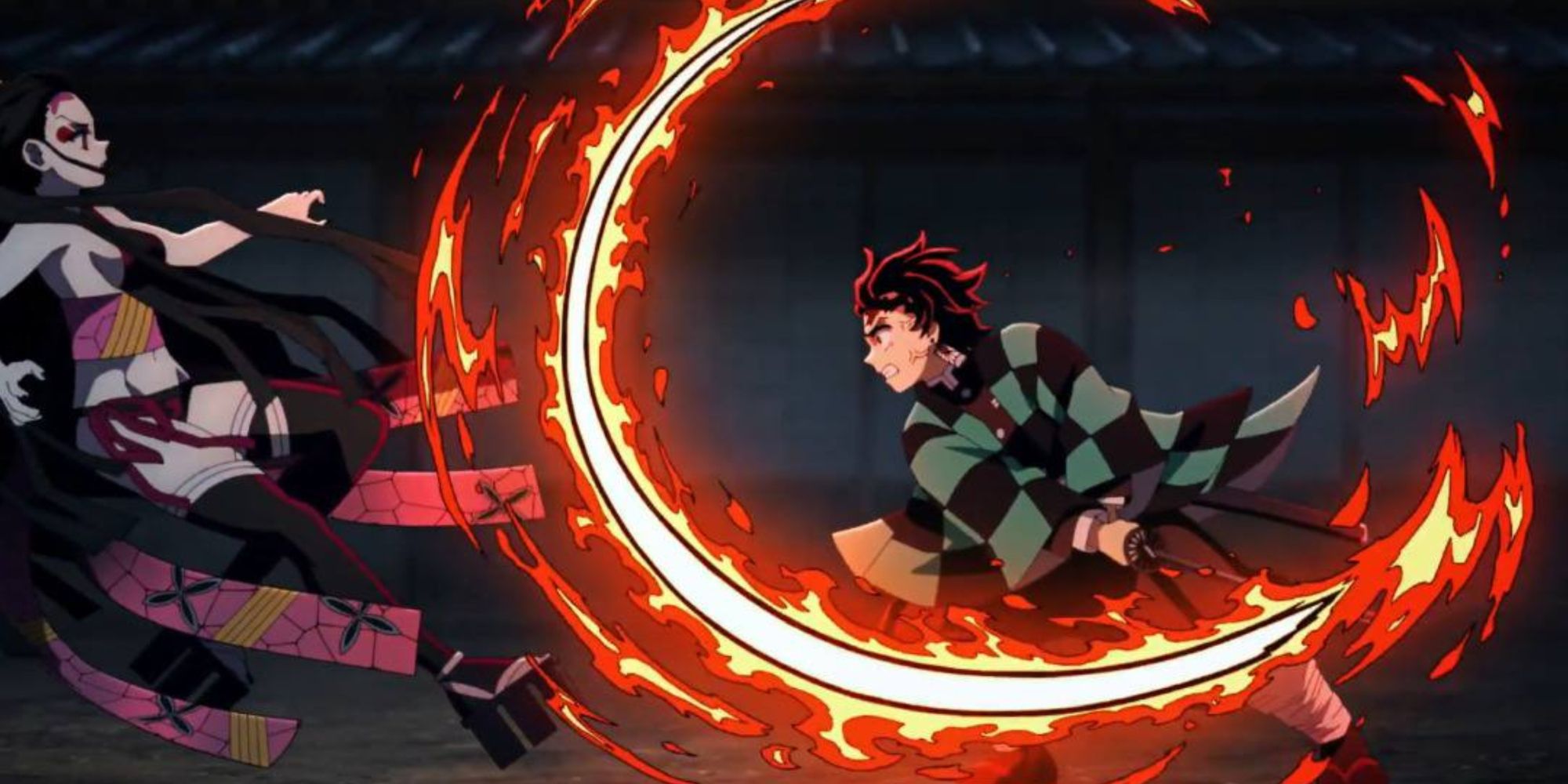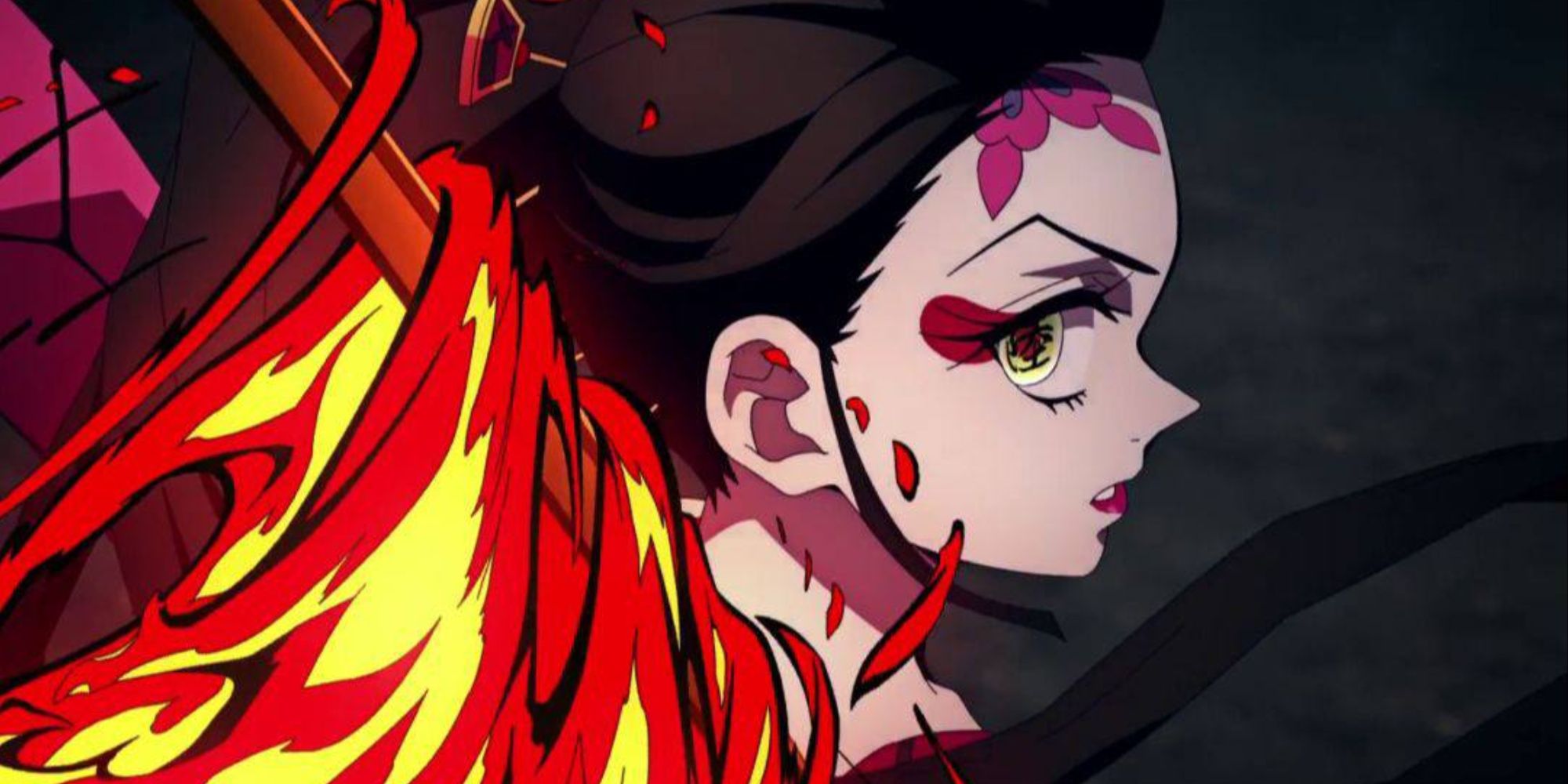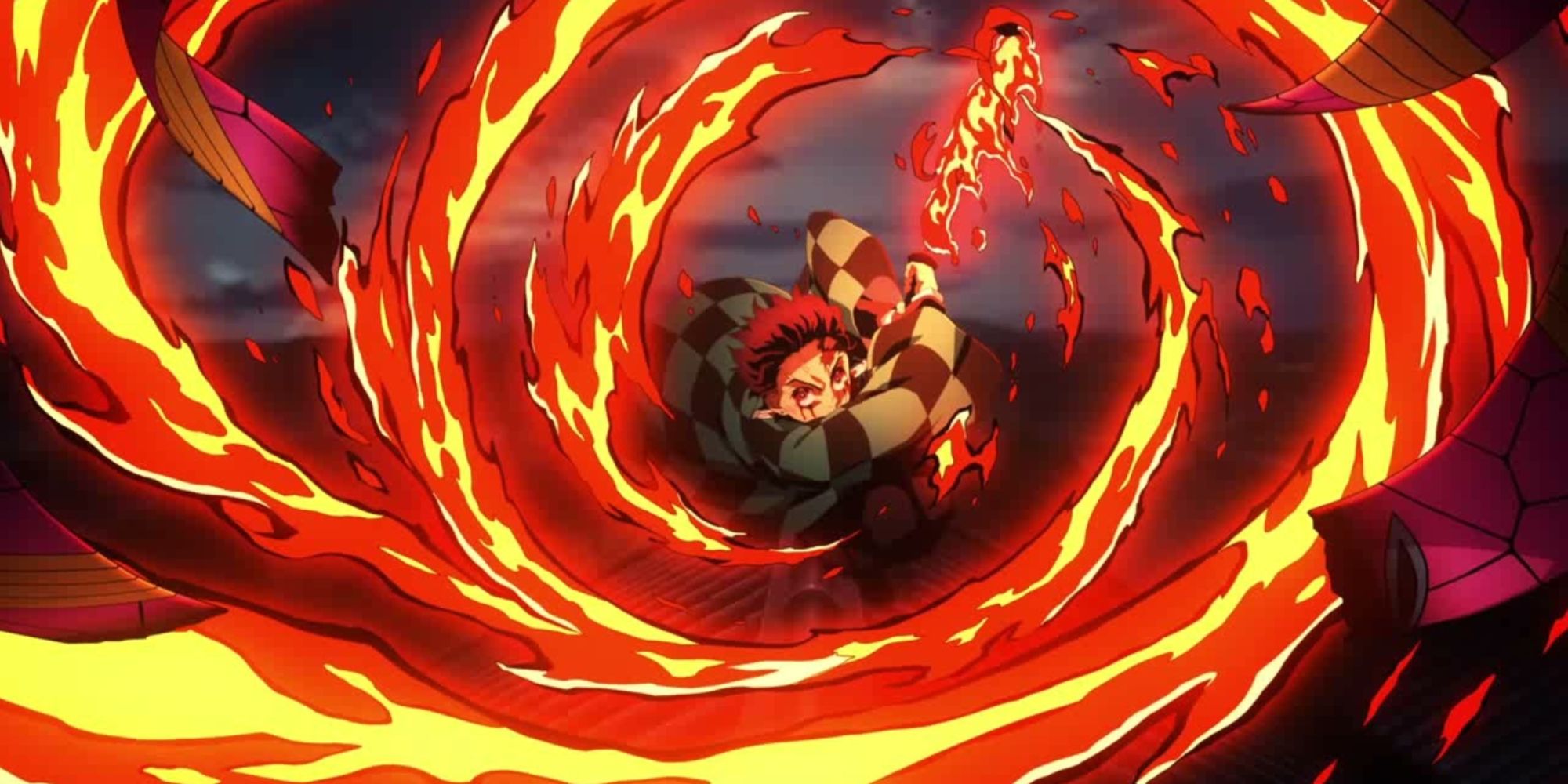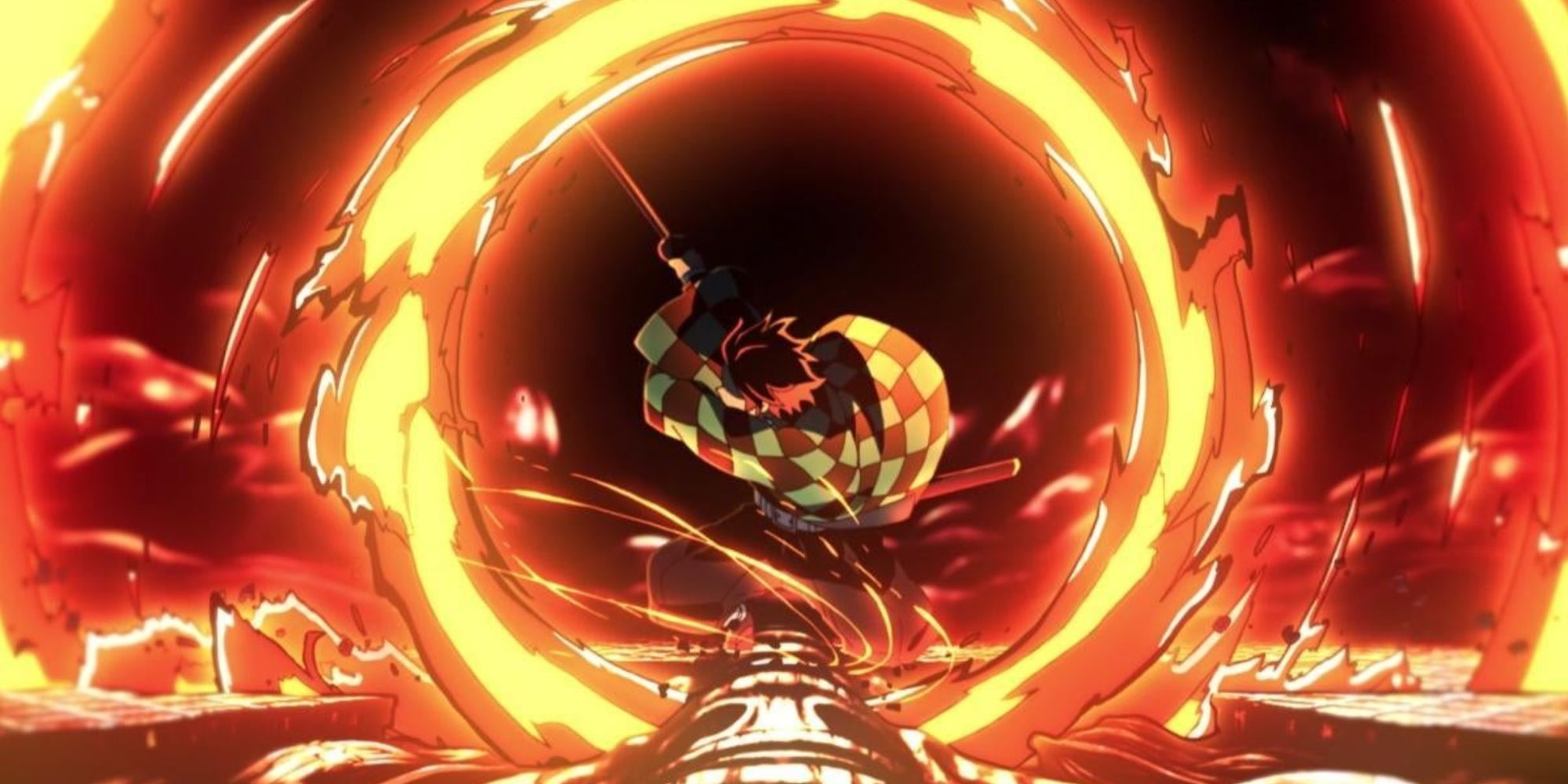Kamado Tanjiro is the main protagonist of the Demon Slayer series, who originally lived the peaceful life as a regular coal burner. However, after most of his family was slaughtered by the demon king Kibutsuji Muzan, the young protagonist sought out the former hashira Sakonji Urokodaki and armed himself with powerful techniques under the Water Breathing style.
Breathing styles allow individuals to enhance their physical capabilities and perform powerful attacks facilitated by unique breathing patterns. Over the course of the series, Tanijiro unlocks multiple breathing styles, but only two have been shown in the anime so far. This list contains all the styles that Tanjiro has performed in the anime and the different techniques classed under them.
17 Water Breathing: Fourth Form – Striking Tide
- Season 1: Episode 4
After completing his training under Urokodaki, Tanjiro took part in the Final Selection, a test to determine if an individual would become a demon slayer or not. The test required its participants to stay alive for seven days in a demon-infested mountain, meaning they’d either have to fight or avoid demons for the entire period.
While on the mountain, Striking Tide was the first form Tanjiro used. It uses flowing movements, allowing its user to perform multiple consecutive strikes to overpower their opponents. Using this form, he was able to take down two demons, an impressive feat considering how little experience he had up until that point.
16 Water Breathing: Second Form – Water Wheel
- Season 1: Episode 4
While on the Final Selection mountain, Mount Fujikasane, Tanjiro also encountered the vengeful Hand Demon. This demon resented Urokodaki for capturing him and took out his anger on all of Urokodaki’s disciples who had ever participated in the final selection. He had managed to kill thirteen disciples so far and was determined to make Tanjiro his fourteenth victim.
As the Hand Demon was about to devour a random participant on the testing mountain, Tanjiro temporarily sliced off some of its hands using the Water Wheel. This form allows its user to generate significant force by jumping into the air and spinning in a vertical motion, effectively slicing anything it comes into contact with.
15 Water Breathing: First Form – Water Surface Slash
- Season 1: Episode 4
Tanjiro’s fight against the Hand Demon was difficult, as it was by far the strongest demon he had faced up until that point. The demon could attack over a long distance with an unnatural number of hands, all of which could regenerate immediately after being cut. In addition, it had an incredibly tough neck, as shown in the flashback where Sabito’s sword broke upon contact with it.
Despite this, Tanjiro still put up a good fight against it and eventually decapitated the demon with his Water Surface Slash. When using this form, he is seen approaching his target at incredible speed, after which he performs an extremely powerful horizontal slash.
14 Water Breathing: Eighth Form – Waterfall Basin
- Season 1: Episode 6
After surviving the final selection, Tanjiro embarked on his first job as a demon slayer, journeying to a town where young girls have been disappearing at night. The disappearances were revealed to be caused by the Swamp Demon, a demon able to duplicate itself and drag others into its personal dimension through a movable opening in the regular world.
While fighting the evasive demon, Tanjiro finds a way to pinpoint the spot at which it would appear from its pocket dimension. However, he is surprised by the number of demons that emerge, so he uses the Waterfall Basin to escape their clutches. With this form, he unleashes a powerful downward slash, creating the optical illusion of a waterfall, with enough power to sever the hands of each duplicate.
13 Water Breathing: Sixth Form – Whirlpool
- Season 1: Episode 7
While fighting against the different bodies of the Swamp Demon, Tanjiro decides to enter the demons' underwater swamp dimension to seal off their escape route. Believing he had made a foolish decision to fight them in their territory, two of the demons catch up to him and engage him in battle.
The demons originally outmaneuver Tanjiro, but after considering what technique would be the best fit for the situation, Tanjiro decides to use Whirlpool. This form is said to be more effective underwater than above ground. It involves the forceful twisting of one's upper and lower body in order to create a powerful maelstrom. Using this technique, Tanjiro was able to defeat two of the Swamp Demon's duplicates, severing not just their heads but multiple other parts of their bodies.
12 Water Breathing: Seventh Form – Drop Ripple Thrust
- Season 1: Episode 9
After a brief encounter with Muzan in Asakusa, Tanjiro is led to the demon doctor, Lady Tamayo’s house. He agrees to assist her in her efforts to find a cure for demons but soon after finds himself under attack by the two demons Yahaba and Susamaru.
Susamaru could throw temari balls with tremendous force, and with the help of Yahaba, have them move in unconventional ways. In order to counter these fast-moving balls, Tanjiro’s first move was to use the Drop Ripple Thrust. This form involves a swift stab at a target and was used to reduce the impact of an oncoming temari. It is also known to be Tanjiro’s fastest thrusting technique.
11 Water Breathing: Third Form – Flowing Dance
- Season 1: Episode 9
As the battle in Asakusa intensified, the demon Susamaru grew four more arms, which allowed her to throw many more temari balls and further increase her offensive threat. However, after Nezuko began occupying Yahaba, the balls no longer had their previous degree of unpredictability, and Tanjiro countered this opening by using the Flowing Dance.
This form allows for multiple swift movements in the form of a dance, which all occur in a flowing manner. As a result, the user can perform powerful slashes and deal considerable damage with each move. It allowed Tanjiro to cut through many of Susamaru’s balls and temporarily sever her six arms.
10 Water Breathing: Fifth Form – Blessed Rain After The Drought
- Season 1: Episode 16
Tanjiro originally intended to use this form in his fight against the Swamp Demon but was unable to after being caught off guard. However, in the Mount Natagumo Arc, Tanjiro used it to blissfully decapitate the Mother Spider Demon; a demon who had been controlling random demon slayers through barely visible threads.
This form allows its user to deliver a single, calm strike that holds no malice or contempt. Tanjiro used it to express his sympathy for the demon’s predicament, and it was shown to have the intended effect.
9 Water Breathing: Ninth Form – Splashing Water Flow Turbulent
- Season 1: Episode 13
This form was first used in Tanjiro’s battle against Kyogai, the former Lower Moon Six of the Twelve Kizuki, a group of demons known to be the strongest of their kind. After a long, difficult battle, Tanjiro composed himself and gathered the necessary resolve, moving in for the finishing blow with Splashing Water Flow, Turbulent.
This move allows its user to adapt to various environments by minimizing the landing time and surface area needed to approach their target. It heavily takes footwork into account, creating the optical illusion of its user running across little bodies of water, after which they can easily decapitate their target.
8 Water Breathing: Tenth Form – Constant Flux
- Season 1: Episode 19
While on Mount Natagumo, Tanjiro faced the formidable Lower Rank Five, Rui. He possessed power unlike any demon Tanjiro had ever seen and could control unbelievably strong threads, as shown when they broke Tanjiro’s sword early on.
Though Tanjiro was originally powerless against Rui’s threads, he began to make progress after using the Tenth Form: Constant Flux. This form allows its user to gain more power as they perform multiple rotations, visually represented on-screen as a roaring water dragon. With this, Tanjiro was able to deflect Rui’s normal threads and eventually start slicing them.
7 Hinokami Kagura: Fake Rainbow
- Season 2: Episode 5
In an attempt to rescue Tengen Uzui’s wives and take care of the demon residing in the area, Tanjiro and his group accompanied the Sound Hashira to a certain entertainment district. While there, Tanjiro encounters and confront’s Daki, one of the two demons that hold the position of Upper-Rank Six.
In order to make the upper rank drop her guard and create an opening, Tanjiro used the Fake Rainbow form of the Hinokami Kagura. This technique allows its user to make movements so quick that they create an afterimage that can be used to deceive their enemies. Its effectiveness is shown when Daki believed she had decapitated Tanjiro. Instead, however, she had only attacked his afterimage.
6 Hinokami Kagura: Dance
- Season 1: Episode 19
During the fight against Rui, in the face of absolute despair, Tanjiro pushes past his limits and unlocks a new form of breathing called the Hinokami Kagura. This style is facilitated by a special type of breathing and dance passed down to him by his father. It is hard to maintain, but it helps Tanjiro perform even deadlier attacks.
After employing this new breathing style, the first form Tanjiro uses is Dance. It was used with Constant Flux, so the original water dragon turned into a menacing fire dragon, roaring as Tanjiro performed an incredibly forceful forward slash.
5 Hinokami Kagura: Raging Sun
- Season 2: Episode 5
Early in the fight between Tanjiro and Daki, the young demon slayer was left in a difficult situation after her obi attacks constantly overpowered him. As a result, he decided to use the Hinokami Kagura as it suits him better than Water Breathing. However, he had never been able to safely perform two consecutive strikes with it up until that point.
Steeling his resolve and taking inspiration from the late Kyōjurō Rengoku’s words, Tanjiro surmises that after all his training and experiences, he should be able to manage it. Soon after, Daki attacks him with her obi, but this time, he repels her using his Raging Sun technique. With this form, he performs two consecutive horizontal slashes and effectively cuts through Daki’s obi.
4 Hinokami Kagura: Flame Dance
- Season 2: Episode 5
Tanjiro had constantly been on the defensive after engaging in combat with Daki. However, after switching to the Hinokami Kagura, he gained a lot more confidence and resolved to perform some attacks of his own.
His first attack came in the form of Flame Dance. This differs from the previous Dance as this is intended to be a two-hit strike that considers the possibility that its target might dodge the first one. The first strike consists of a vertical slash, as seen when Daki evaded it, and the second is intended to consist of a horizontal strike.
3 Hinokami Kagura: Fire Wheel
- Season 2: Episode 5
After performing two techniques facilitated by the Hinokami Kagura, Tanjiro finally saw a stable Opening Thread on Daki’s neck; an imaginary piece of string that serves as a visual aid to help Tanjiro identify when and where there is an opening that would allow him to decapitate his enemies. After seeing this opening, prepared to deliver the final blow, Tanjiro uses Fire Wheel.
This technique is somewhat similar to the previously mentioned water wheel, but this time it is performed using the Hinokami Kagura. While using it, however, Tanjiro begins his strike from an inverted position and performs a slash rotating upward from a downwards position.
2 Hinokami Kagura: Burning Bones – Summer Sun
- Season 2: Episode 6
Late into Tanjiro’s confrontation with Daki, the latter enters her complete form and gains strength incomparable to what she had before. Soon after, she is annoyed by a district resident and, as a result, uses her obi to cut down every house in range, killing many people in the process. This immensely infuriates Tanjiro, who pursues her with eyes bloodshot from rage.
She notices a change in Tanjiro’s aura and attempts to finish him off with an obi attack strengthened by her new form and Blood Demon Art. However, Tanjiro counters with the Burning Bones, Summer Sun. This technique consists of a strong spiral slash that inflicts lasting damage on its target, as shown when Daki remarked that she felt a burning sensation from her obi.
1 Hinokami Kagura: Clear Blue Sky
- Demon Slayer: Kimetsu no Yaiba – The Movie: Mugen Train
During the Mugen Train Arc of the series, Tanjiro and his group were ordered to join the Flame Hashira Kyōjurō Rengoku on his mission to investigate the disappearance of forty people on an ominous train. The cause of the disappearances was revealed to be the Lower Rank One demon Enmu who had the power to put people to sleep and kill them while they dream.
Enmu had fused his body with the train. As a result, it took a while for the demon slayers to identify his neck. After finding his neck, Tanjiro used Clear Blue Sky to cut through it. The move involves a complete 360-degree horizontal slash that possesses tremendous power, proven by the fact that it helped Tanjiro slay his first real Kizuki.

